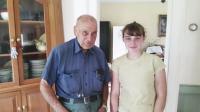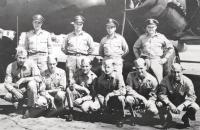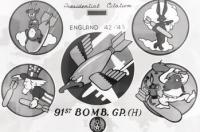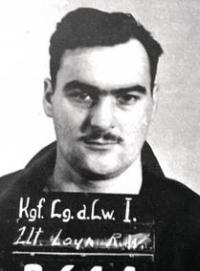Main Sections
Front Page
SportsValley VitalsIt's in the StarsStarwiseArchivesLinksAbout The VoiceContact Us
|
Land Air And For Freedom Sharing Memories With Roger Layn

photo by Cookie Step Roger Layn and his great-granddaughter Charlotte are glad the summer sun stays up longer because the pair always has projects to work on involving animals, farming and the land.
|
| 
photo by provided Flight crew photograph for B-17, My Prayer. Roger Layn is the second from the left, standing in the back row.
|
| 
photo by provided These are the insignias of the groups and men that Roger Layn served with and flew with. 91st Bomb Group (large in the center) and squadron (smaller ones on the outside) Insignias.
|
| 
photo by provided This was Roger’s Prisoner of War mugshot while he was in the German prisoner of War camp during World War II.
|
|
Tuesday August 23, 2016
By Cookie Steponaitis
Roger Layn has a view from his farm house that no one who appreciates life in rural Vermont would ever tire of with fields of corn that wave in the breeze at the base of a rising mountain. The dirt road winding past his place is well worn and bears the marks of tractors, equipment and the four wheelers of grandchildren. Layn, rising from his chair smiles and holds out a hand with a firm grip. At 96 he has just come in from brush hogging most of the day and offers to go inside where it is more comfortable. Work is not only a way of life for this Monkton farmer but one that gives him zest and vitality. In a life spanning almost a century Layn has seen a large part of the world and at a young age experienced situations far beyond most of what our modern minds can understand. Roger Layn has been happily tied to the land from birth and is a quiet presence with a story that defines not only his life but a time when America came of age.
Layn was born in Starksboro in 1920 and grew up on what was a relatively large farm for that time. “We had fifty-one head of cattle,” explained Roger. “I can remember my mother canning a whole beef in jars. We had no electricity and every night before we went to bed one chore was to clean the lamp chimneys. Milk was placed in cans and picked up every day. My dad put ice up in the ice house and we used it to keep the milk cool. I know that is hard for kids to visualize today, but it was how farming in Vermont ran for a very long time. During the Great Depression we didn’t live high but we always had food living on the farm.” Gesturing to the ornate older phone on the wall of his farmhouse Layn smiled, “This is the first phone we had. It was quite something when the power line came through. We had one mantle lamp in the barn and one in the house.
While Layn credits his father as being the expert dairyman, it was the mechanics of things that intrigued Layn. “My father had the first International Tractor in Addison County with rubber tires,” shared Layn. “That was a hard time in farming as the family lost three herds to TB. Moving to his uncle’s farm which is still where Layn lives and farms today, Roger’s family experienced a barn burning and other events that would have stopped some people. “My father bought the farm down the road and I have added acreage to it as well,” explained Roger. “My son David runs the operation now.”
Layn took the word of the recruiter when enlisting during World War Two that he would be an airplane mechanic and instead found himself in ammunitions and ordinance. Layn remembers while in training at Manchester, New Hampshire being in the movie theater when World War Two began for America on December 7, 1941. “They turned up the lights and turned off the film and explained what had happened.” The change for Layn and others was immediate. Two of his friends were sent to 20 MM school in Michigan. One served in Italy and the other in the South Pacific. Lane remembers vividly one morning during roll call when he was called to the orderly room. “I wondered what I had done,” smiled Layn. The officer in charge had two sets of orders.One would send him to school in Maryland and one would send him to pilot training in Nashville, Tennessee. Layn chose pilot training and joined a group of Bristol men who were aviators. “Rob Hazelton, Donald Wilson and Jim Bouvier were all navigators or pilots,” explained Layn.
In a dizzying array of schools that added geography, distance and training to his life, Roger Layn found himself in Arkansas, Indiana, home for a two week leave, Moses Lake, Washington, Walla Walla, Washington, Grand Isle, Nebraska, Bangor, Maine and Newfoundland before his entrance in the European Front. Layn began his training on a single engine plane, advanced through twin engine, rated pilot and three levels of training to fly a new plane of the era the B-17 known as the Flying Fortress which was a heavy bomber used in the American Air Force from 1938 to the late 1960’s. A total of 12,000 of these fast flying long range bombers were used to drop more bombs than any other plane in World War Two. “We flew at an average of 28,000-30,000 feet,” expressed Layn. “It was so cold. There is nothing else I have experienced to compare to that level of cold. Our tanks held 2800 gallons of fuel and we carried a crew of ten and a payload of twelve five hundred pound bombs. Let’s just say that she was rather reluctant to leave the ground with all that weight. Our crew consisted of a pilot, co-pilot, navigator, bombardier, radio operator, left waist gunner, right waist gunner and a tail gunner. There was a kind of rivalry between us and the B-24 crews. We called the B-24 the box the B-17’s came in.”
The crew met their brand new plane and went through training in Newfoundland. “We flew radio beam to Prestwick, Scotland,” recollected Layn. “The weather was bad and we hit ice at the higher altitude. All of a sudden we heard a huge crash into the side of the plane. It was ice breaking up on the plane. Even though we were bent on kicking the hell out of the Germans, they pulled the planes from us and sent us into more training before we went out to fly bombing missions. Flying out of Cambridge, England as part of the 91st Bomb Group, Layn was part of Squadron 322 and is credited for flying ten and a half missions. Each bomb group had four squadrons and approximately twenty five planes. The B-17 needed more than a football field to take off according to Layn who feels that the ground crews that kept the planes ready for battle never got the credit they deserved. “Each plane had its own ground crew and they worked in all weather and often had to pull and replace engines at night and make repairs of all sorts.”
Layn and the bomb group often found themselves with missions over France and Germany taking on heavy fire from the Germans. “We lost a total of sixty planes,” explained Layn. “We had a fire in our cockpit and the whole plane was filled with smoke.” Layn was referring to the Schweinfurt-Regensburg mission where the B-17’s flew in an ambitious mission to cripple the German aircraft factories with two strikes in the same mission attacking in waves and at different targets. The strike involved 376 bombers and inflicted severe damage but the loss of sixty bombers was catastrophic. The long range fighter planes for the Allies were only able to escort the B-17s part of the way because their fuel tanks did not allow for the distance which slowed the use of the B-17s for five months until the solution could be found for the escort fighters. Layn was shot down and spent fifteen months in a German POW camp until he was freed by the Russian Army. Layn who is not one to discuss this phase of the war, simply shares, “that the experience changes a person and makes them know what they value and what is important.”
When Roger returned home he married Helen Burritt Layn in 1947 and the young couple shared not only a love of the land and Vermont, but an incredible understanding of the costs of war. “My wife I think had even a more difficult tour than I,” explained Roger. “She was a nurse in the 7th Field Hospital. After getting her nursing degree from Mary Fletcher Hospital in Burlington she was a part of the nurses and doctors that followed the battles across Europe and worked on soldiers in triage tents.” They were married sixty five years before Helen passed away. The Layn’s raised children Craig, Candace and David on the farm and enjoyed not only the lifestyle but the children, five grandchildren and a passel of great-grandchildren.
Layn enjoys working with steel and wood and explained that in addition to fixing equipment, “I like to take most equipment and improve on it.” He is known locally for working on lots of special projects and many days can be found in his shop working on the newest projects. Roger Layn cherishes his small town life and chuckles about the ingenuity of people and the different ways people get together to play and raise money and whether it is a pancake dinner, a Mud Bog or a new farm project, Layn is up to the challenge. Friend and fellow Old Fart Club member Max Dumas says of Layn’s skills, “He simply can make anything and is still out there in that shop of his doing it.”
At the conclusion of the interview, great-granddaughter Charlotte stopped into see if Roger had enough energy left after brush hogging and working on the farm. “Sure I do if you do,” smiled Roger and the pair went out to the shed to start another project. The secret to Layn’s longevity is simple if you ask him. “I enjoy working and I enjoy the farm,” he explained. “I am not one for tooting my own horn and simply enjoy living.” Pulling out a cell phone from his pocket, Layn frowns and looks at it with a bit of skepticism. “My kids got me this and told me to carry it in case I fall down somewhere. It has my kids’ names and numbers in it. All I have to do is push a button.” With a sigh he puts it back in his pocket and added, “I guess I am kind of set in my ways, but if it makes them happy.”
With a handshake and a quick drink of water, Roger Layn and Charlotte go to work together. One set of hands teaching the next and passing on lessons about life, land, animals and how to balance of work, family and celebration is something to behold and when the senior member is 96 it takes on another layer of meaning. Grounded in the circle of life and in the blessings of being free, Roger Layn lives as he has always done, with both feet on the land, his hands on his tools and his heart with his family, his work and the country he helped to protect.
Mt. Mansfield Media and the Heritage Automotive Group have created a series of videos honoring these remarkably men and their legacy to the state and generations of Vermonters. Please go to addisoncountyfilm.com and look for video links to Dean Jackson, Lucien Paquette and Roger Layn.
|
Advertisements
Search our Archives
|






 Printer Friendly
Printer Friendly